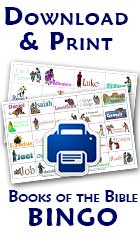|
Review Activities
Gameboard a game board that can be used with any
lesson, and instructions for its use. See the bottom of the
page for ways to
deal with common
review game problems.
|
|
| Alphabet Game |
 Pick
a letter from the alphabet. Give the students 5
minutes to write down or call out as many Bible
people or places that start with that letter
as they can. Set a goal of 5, 10, etc. for the
class.
See Outburst and for
similar professionally produced games. Pick
a letter from the alphabet. Give the students 5
minutes to write down or call out as many Bible
people or places that start with that letter
as they can. Set a goal of 5, 10, etc. for the
class.
See Outburst and for
similar professionally produced games. |
Bible Baseball
Encourage students to complete their homework: allow
them to use their workbooks to answer questions |
- Make questions from the lesson
or use homework. Divide the class into two
teams, (permanent ones are good). Make a
baseball diamond and 2 sets of markers to
represent the two teams, Pattern for game pieces. (4 markers each).
-
- Flip a coin to see which team
goes first. The first person up to bat must
answer a question correctly by himself.
Team members cannot give the batter the answer.
If he answers correctly, his marker goes to
first base. If he answers incorrectly, the
question goes to the next batter on the team.
Each incorrect answer is an out; three outs and
it's the next team's turn. Determine the number
of innings per game by the size of the class.
-
- (Let the students personalize
their game piece if they want. Long games can be
played on a continual basis, just set the game
aside at the end of class and pick up next
time.)
For a professionally made gameboard with pre-written
questions, see below. |
Bowling
submitted by a reader |
| We play a game similar to the baseball game on your
site, except bowling. I set up 10 plastic bottles,
(I use baby bottles, but empty 2 liters or 20 oz are
quieter). Each time a student answers a question
from the lesson correctly they get a chance to bowl.
If they can't get the answer then I will let one
person help them from their team. I give them two
chances to bowl (with a rubber ball) and then move
to the other team. We usually play boys vs. girls. |
Campfire
(submitted by Wendy) |
During the lesson we sit around a fire (like a camp
fire). We ask questions about the lesson. Then as
each child got the question correct, we allowed them
to throw a small piece of wood into the fire. After
all the children had a chance to answer a question
and through wood in the fire, the class roasted
marshmallows. They really enjoyed this and if was
like us having an altar like Abraham, Noah or other
Patriarchs.
|
Concentration
sample |
Good for primaries. Draw or cut out pictures
relating to the lesson in fifteen matching pairs.
Mix up the cards and place them face down on a table
or the floor, or tack to the wall (with adult help).
Students take turns turning over two cards. If the
cards match, the student keeps them, and gets
another turn (if group small enough). If the student
does not match a pair, the cards are replaced face
down and his or her turn is over. The student with
the most pairs wins. For larger groups, make several
sets or break into teams. |
| Crossword with a Twist |
Make a crossword grid of words from the lesson. Make
small cards of alphabet letters that are in the
words and place them in an envelope. Ask review
questions of two teams. If the question is answered
correctly, pull a letter from the envelope and fill
in that letter wherever it is on the grid and give
that team a point. Teams can use a turn to guess a
word correctly, which earns them extra points.
|
| Find the Verse |
Juniors. Use this activity to familiarize students
with books in the Bible. Write a list of Bible
verses, concentrating on relevant verses or specific
books you want students to find.
Have students sit with their Bibles closed in front
of them. When the teacher reads the citation,
students look for the verse. The first student to
find the verse reads it. Then that child can pick
the next one. This can be done in teams or pairs as
well.
Available from Christian Book Distributor
NLT Hands-On Bible, Softcover
By Tyndale House
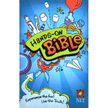 Jesus
taught with hands-on lessons and illustrations. The Hands-On Bible uses the same experience-based
learning to communicate God's Word in an active,
understandable way. This new edition features
updated tip-ins, a more portable size for kids, an
attractive cover, and online parenting helps. With
hundreds of fun, memorable activities (A "do it"
activity in EVERY feature!) and the full New Living
Translation text, the Hands-On Bible is
packed with activities and experiences that invite
kids to crawl inside the Scriptures and "do" God's
Word! Jesus
taught with hands-on lessons and illustrations. The Hands-On Bible uses the same experience-based
learning to communicate God's Word in an active,
understandable way. This new edition features
updated tip-ins, a more portable size for kids, an
attractive cover, and online parenting helps. With
hundreds of fun, memorable activities (A "do it"
activity in EVERY feature!) and the full New Living
Translation text, the Hands-On Bible is
packed with activities and experiences that invite
kids to crawl inside the Scriptures and "do" God's
Word!
|
| Fishing |
| Draw or make a simple fish on paper, and a fishing
hook. (see sample)
Place the fish on a bulletin or flannel board. Place
a drawn wave with nine troughs in front of the fish.
Place the hook over the fifth trough. Ask the
students questions from the lesson. For each correct
answer, move the hook closer to the fish. For each
incorrect answer move the fish further away. If the
students catch the fish, they win. Adjust the
beginning place of the hook for the difficulty of
the questions. |
| Jeopardy |
Write questions about the lesson, or use the
workbook's questions. Divide the questions into 5
categories, assigning a value to each question.
Divide the class into teams, giving them points for
each question they answer correctly. For incorrect
answers, subtract the points, then let the other
team attempt to answer the question.
|
Just Like Us
(submitted by Jenny Hartnett) |
Here's a game that you can play with kids who are
familiar with many Bible stories. It works well with
groups up to 20 students. Materials: two pieces of
sturdy paper that can be run through your printer;
cube pattern from this link;
tape; marker. Run the pattern through the printer to
make two squares. Write adjectives in the middle of
each square that describe personalities. Include
both positive and negative traits. You'll need 12
words. Some suggestions are: vengeful, depressed,
friendly, helpful, sullen, kind, generous, wise,
thoughtless, selfish, trustworthy, pure in heart.
Cut out the patterns. Tape the squares together to
make a cube after writing the words on the sides.
You may want to stuff them with something
lightweight but filling so that they do not
collapse. I use crumpled paper on the insides.
Introduction: Bible characters, although they lived
long ago, are not so different from us. God
included.
|
| Mix and Match |
Having students sort items into categories can help
reinforce the lesson, and can be used for readers
and preschoolers.
Examples Sort books: Draw a large Bible on a poster, and put
a pocket on the left for the OT and a pocket on the
right for the NT. Write the names of the books of
the Bible on 3x5 cards. Have students place the
books in the correct pocket.
Sort situations: Write in colored ink "Golden Rule"
"Silver Rule" & "Iron Rule." Give each student a
token. Describe a situation or action and have
students place their token on whichever rule they
think was used.
Sort people: you can divide Bible characters by good
and bad; new and old testament; apostles vs.
non-apostolic NT author, etc. |
| Musical Blessings |
Good for primaries,
requires space. Lay several pieces of
colored construction paper on the floor in a
circle. Have at least as many papers as you
have students. Have students stand one per
paper. While you sing, students follow each
other around the circle. When you stop, they
end up on a color. Have each student name a
blessing that relates to the color they are
on (e.g. green=trees).
-
- Variations:
Relate the activity to the lesson; mix an equal
number of black in with the colors - when the
students land on a color, have them state a
positive; on black, a negative. (e.g. good vs. bad
behavior in church, nice vs. mean, etc.)
Use as a memory aid. List a subject category and
have them name 1 or more people, places, items in
the category. (e.g. apostles, NT books, miracles of
Jesus, tribes of Israel, prophets, Kings of Judah,
etc.)
Play like musical chairs, eliminating one piece per
round. Have the paperless student recite the memory
work, answer a lesson homework question, name a
blessing, etc. Let eliminated students take turns
doing the singing. |
| Musical Review |
| Write review questions on cards and put into bag or
box. Pass the bag around the room while singing.
When you stop singing, the child with the bag pulls
out a question. If he or she can answer it, they
keep it. If not, it goes back in the bag. |
| Name That Object |
Pick an object and give students clues as to what it
is, starting with difficult up to easier clues. You
can have the whole class guess, or give students
turns, with the next student getting to guess on the
same clue. Or divide the group into teams. Examples
are on the worksheet. For a game that already has made up
these questions, see below.
| Available from Christian Book
Distributor |
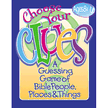 Choose
Your Clues Choose
Your Clues
Learn the Bible with this exciting game! Simply identify the Bible person, place, or thing with as few clues as possible. You try: "I'm liked by a donkey. Sometimes I'm empty. Angels spoke of me." (A manger.) Over 2,000 "hints" help you discover Bible facts you never knew existed! Includes rules for three fun-filled variations. Ages 8 and up. From Christian Book Distributors.
|
|
| Name that Word |
| Choose two students as contestants and give them
each a score of 50 points. Use the rest of the class
as audience. Pick words from recent lessons and
whisper one to each contestant in turn. The student
them must try to get someone in the audience to
guess what the word is without saying the word.
(e.g. camel It has humps. It doesn't need much water. It is
hairy.) Subtract from each student's score the
number of clues it took for the audience to guess
it. |
| Pictionary |
| Write the names of people, objects, songs, and
places from the story on 3x5 cards. Have one student
at a time pick a card. The student will try and draw
the word on the chalkboard, while other students
guess what it is. You can divide the class into
teams if you'd like, or simply award tokens to the
first student to guess. Or do the drawing yourself
and have the students guess. |
| Question Matching |
Write questions and their answers on separate cards.
Place the answers around the room and hand the
questions to the students. Have the students hunt
for the answer.
Variation: Give a question and an answer to each child. Have
them find the student that answers their question
and the student whose question matches his or her
answer. |
|
Rapid Fire by
Patti Barker |
Obtain swizzle or craft sticks. ( I buy them at
Target) Choose sticks that are sturdy, hard to break
and colorful. Buy at least 30 to 50.
Compile a list of questions from Bible class. (See
her list or use review questions within each
lesson on this site). Keep the questions simple and
to the point. Print the answers and the verses to
each question. I use tree colors when compiling my
list: black for questions, pink for answers and
orange for verses.
The object of the game is to be the first to answer
a question and acquire a stick. The first one to 10
sticks wins! The children shout out the answers in
rapid fire� fashion. The game is loud and lots of
fun. The rules are simple:
The first one with an answer shouts it out ahead of
the others and has the floor, the other children
have to be quiet while the answer is given. If the
answer is wrong, the child forfeits a stick. If
right, he/she gets one!
Keep the game fast paced. The first person with 5 or
10 sticks wins, depending on what we determine at
the start of the game. At the end of the game, all
the sticks are counted and then returned.
Print out ALL the questions every few weeks so the
students can study at home if they want to. You can
also give the parents copies so that they can help
their children learn. |
| Review Race |
- Write the answers to the lesson's questions
on two sets of cards. Post each set separately,
perhaps surrounded by a border or picture.
Divide the class into two teams. Ask team number
1 a question. One member goes up to select an
answer from the board. If it is correct, the
team keeps it. If not, the answer is replaced.
Alternate between teams. The team that removes
the most answers wins.
Variation: Give each team a set of answers. Have the team place
the answer on the board. If it is correct, it stays.
If not, they get it back. The team with the most
correct answers wins. The answers can be printed on
pictures, e.g. fruit, and the bulletin board have
two trees. |
| Tic Tac Toe |
| Small groups. All ages. Write or use questions based
on the lesson, or as a review of several lessons.
Have at least twenty for two games. Break the class
into sets of two, Xs and Os. Read a question for the
Xs. Whoever gets it right gets to place his or her
X. If he or she does not answer correctly, no X is
placed. Then read a question for the Os, and so on.
Variations: A single student can play the
teacher, who can flip a coin to determine whether or
not a letter is placed. Or, divide the class into
two teams, and let them answer the question
together. If team X answers incorrectly, let team O
answer the question. |
| True and False |
| Ask true/false questions relating to the lesson. For
small groups, label one wall true and another false.
(I use a smiley face and frowney face for
preschoolers). Have students move to the side they
think is right. For larger groups, give
each kid two cards, T and F. Have them raise the
card they think is right for each question. |
| Twenty Questions |
| Have in mind a person, place or thing related to the
story. Explain to the students that they have 20
yes-or-no questions to ask to find out what it is.
Let students take turns asking the questions. For
younger students, tell them if it is a person, place
or thing, and guide them through the process. Use as
an opener to introduce the story. Variation: Have an item in a bag and play 20
questions to guess what's in it. |
Mother Knows
Best
Contributed by Jerri Fusch |
| This game can be used with review questions or
general Bible knowledge. Choose two to three older
girls to be "mothers." The "mothers" sit on chairs
in front of the classroom facing the other kids.
Divide the rest of the class into two to three
teams. The team members will take turns answering
questions. They will each have a choice of answering
it themselves or asking a "mother." If they answer
it correctly by themselves, their team gets 200
points. If they ask a "mother" and she answers it
correctly, the team gets 100 points. If the answer
is incorrect, the team gets 0 points. In any case
the turn then goes to the other team with a new
question. |
Who Has...?
(contributed by reader Paula) |
| With the books of
the Bible cards, after they have been passed out
(depending on class size, each student can have at
least 3 cards), the teacher can name a book, a story
that is found in one of the books, an animal, a
place, etc. and whoever has it puts it down on the
table. It can be done in teams and the team that
gets all cards on the table first wins. Of course,
don't give out all the cards and randomly give info.
Can also be used with Bible
Trading Cards. |
|
Dealing with
Embarrassment
If you are dealing with pre-teen students, you likely have
at least one student who doesn't want to answer or ask questions for fear of
embarrassment. One way to elicit answers from students in this environment is to
get them to write the answers on a blank piece of paper, and pass a bowl around
to collect the answers. Have students write (No Answer) if they don't know. That
way, everyone looks like they have written an answer and contributed. No one
knows whose answers are wrong, right, or non-existent. Thanks to a workshop
attendee for this great idea!
Dealing with Overeager Students
What do you do with the student who knows all the answers? You can't
punish her for being good, but you want to encourage everyone to
try. Here's a great solution contributed by a seminar attendee: At
the beginning of class, issue each student a set number of tokens
(craft sticks, chips, whatever). During the class, each student will
have to answer as exactly as many questions as they have tokens.
Each time they answer, they turn in a token. This keeps the active
student from monopolizing the conversations, and encourages the
reluctant student to participate. Since everyone is in the same
boat, the shy student is not being highlighted. Great idea! |
Related Pages on Activities
|
Use the included questions or substitute yours in the following games.
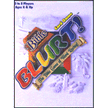
Don't think long and hard, think fast and fun! Find out if your brain can keep
up with your mouth and if your mouth can keep up with your brain! The words are
taken from the NIGV Bible and the play of the game is lightning-quick. Relax and
enjoy all the funny things people blurt! For 3 to 5 players, ages 8 and up.
Available from
Christian Book
Do U Know? Game
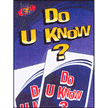
Turn playtime into Bible-time
with this fast-paced family card game! It's similar to
Uno---but in addition to matching colors and numbers,
players must answer questions about Bible facts, characters,
and stories. Perfect for long road trips and rainy
afternoons---it's so much fun, your kids won't even realize
they're learning! Ages 5 and up.
Available from Christian Book
 Outburst: Bible Edition, 2nd Edition
Outburst: Bible Edition, 2nd Edition
Test your Bible knowledge with the Bible Outburst Game. Designed for ages 12 years and older, this fun party game features over 320 topics---players have 45 seconds to match as many top ten answers as they can before time runs out. For 2 teams. Includes 162 cards, card reader, timer, 6 pass chips, 2 dice, score pad, and instructions.
|


 Outburst: Bible Edition, 2nd Edition
Outburst: Bible Edition, 2nd Edition